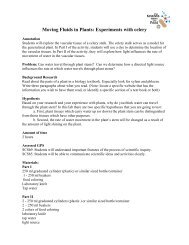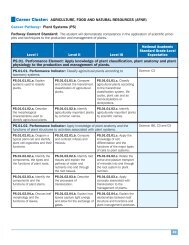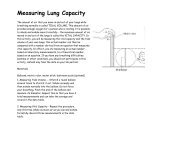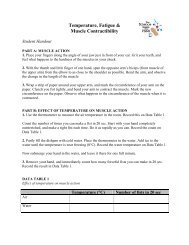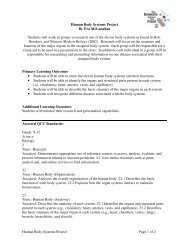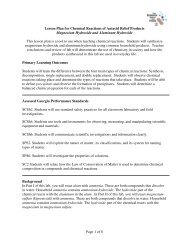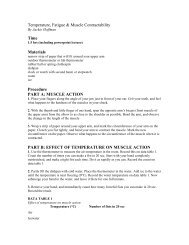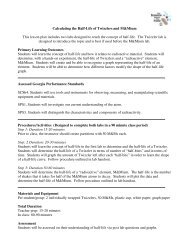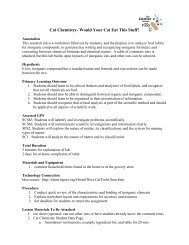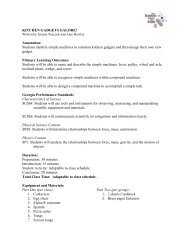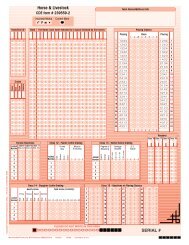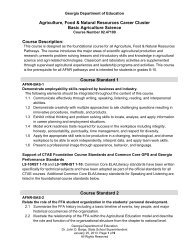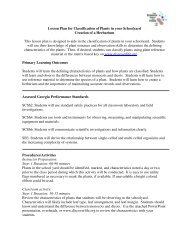Soil Testing
Soil Testing
Soil Testing
Create successful ePaper yourself
Turn your PDF publications into a flip-book with our unique Google optimized e-Paper software.
<strong>Soil</strong> <strong>Testing</strong>http://pubs.caes.uga.edu/caespubs/pubcd/L387-w.htmPage 1 of 612/30/2005Cooperative Extension ServiceThe University of GeorgiaCollege of Agricultural and Environmental Sciences<strong>Soil</strong> <strong>Testing</strong>For Home Lawns & GardensC. Owen Plank, Extension Agronomist<strong>Soil</strong> <strong>Testing</strong> & Plant Analysis<strong>Soil</strong> tests such as those conducted by theUniversity of Georgia <strong>Soil</strong> <strong>Testing</strong> andPlant Analysis Laboratory will help youdevelop and maintain a more productivesoil by providing information about thefertility status of your soil. Information froma soil test will help you select the properliming and fertilization program to obtainoptimal growth of lawn, garden andornamental plants.One of the most important steps in soiltesting is collecting the sample. <strong>Soil</strong> testresults can be no better than the samplesubmitted to the laboratory for analysis. Asoil sample weighing about 1 pound isused to represent thousands of pounds ofsoil in the landscape or garden. Therefore,it is extremely important that soil samplesbe properly and carefully taken.A Good <strong>Soil</strong> Sample Should Be Representative of the Area• Take soil from a minimum of 10 random locations (x) in the sampled area and mix together in aclean bucket.• For trees and shrubs, take soil from six to eight spots around the dropline of the plants and mix.
<strong>Soil</strong> <strong>Testing</strong>http://pubs.caes.uga.edu/caespubs/pubcd/L387-w.htmPage 2 of 612/30/2005• Areas that have been treated differentlyshould be sampled separately. In theabove example, four samples should betaken -- one each from the garden, thelawn, the ornamental shrubs in thelandscape, and the azaleas. If the frontand back lawns have been treateddifferently or if they are seeded todifferent grasses, take a separate samplefrom each.• Areas where plants grow differently and/or thesoil appears different should be sampledseparately.Do Not Contaminate the Sample• Use clean sampling toolsand containers.• Never use tools orcontainers that have beenused for mixing orapplying fertilizer orlimestone. A small amountof residue on containerscan cause seriouscontamination of the
<strong>Soil</strong> <strong>Testing</strong>http://pubs.caes.uga.edu/caespubs/pubcd/L387-w.htmPage 3 of 612/30/2005sample.Sample to the Proper Depth• Remove any surface littersuch as turf thatch or mulch.• For lawns, sample to a depthof 4 inches. For gardens,ornamentals and fruit trees,sample to a depth of 6 inches.• Use a trowel or sampling tubeto collect soil samples. To usea trowel or spade, push thetool to the desired depth intothe soil. Then push the handleforward, with the trowel orspade still in the soil, to makea wide opening. Cut a thinslice from the side of theopening that is of uniformthickness -- about ¼ inch thickand 2 inches wide, extendingfrom the top of the ground tothe depth of the cut. Scrapeaway any grass thatch ormulch, and place the slice ofsoil into a clean bucket orother container. After the soilis taken, remove the shovel orspade and let the soil fall backin place.
<strong>Soil</strong> <strong>Testing</strong>http://pubs.caes.uga.edu/caespubs/pubcd/L387-w.htmPage 4 of 612/30/2005<strong>Soil</strong> Samples Should Be Carefully Mixed and Packaged• Do not use sample bags otherthan those provided by theUniversity of Georgia <strong>Soil</strong> <strong>Testing</strong>and Plant Analysis Laboratory. Allcores taken for a given sampleshould be collected in a cleanbucket and thoroughly mixed.• Fill the soil sample bag to theindicated line with the mixed soil.• Supply all the information askedfor on the soil sample bag. Listyour Name and Address, Plantto Be Grown, Sample Number(please use a simple code and donot exceed 3 digits, e.g. 1, 2, 3, ...20, 21, 22, ... 321, 322 ... 32A,32B ...) and your County. Thisinformation is essential for thereturn of your sample results andfertilizer recommendations to theproper county extension office. Onthe bag, indicate tests desired bychecking the proper box. Forlawns, gardens and shrubs, aroutine test will suffice. If a specialanalysis, e.g. nitrate-nitrogen(NO 3-N), organic matter (O.M.) orboron (B) is needed, first consultyour local county extension office.Samples should be dropped off atyour county extension office formailing to the laboratory. <strong>Soil</strong>sample bags and other pertinentinformation are available at yourcounty extension office.
<strong>Soil</strong> <strong>Testing</strong>http://pubs.caes.uga.edu/caespubs/pubcd/L387-w.htmPage 5 of 612/30/2005When and How Often Should <strong>Soil</strong>s Be Tested?<strong>Soil</strong>s can be tested any time during the year; however, be sure to samplewell in advance of planting or spring green-up. This is particularly importanton areas where lime is likely to be needed. Lime reacts fairly slowly andshould be mixed with the soil several weeks before planting. Generally, fallis the most desirable time to sample soils, because landscapes andgardens are usually dry and easily accessible. <strong>Soil</strong>s should be dry enoughto till when sampling. If wet samples are collected, they should be air driedbefore being placed in the soil sample bag.Once medium or high fertility levels are established, lawn and ornamentalareas only need to be sampled every two to three years. Vegetablegardens should be sampled every one to two years.Leaflet 387/Reprinted March, 2000The University of Georgia and Ft. Valley State University, the U.S.Department of Agriculture and counties of the state cooperating. The
<strong>Soil</strong> <strong>Testing</strong>http://pubs.caes.uga.edu/caespubs/pubcd/L387-w.htmPage 6 of 612/30/2005Cooperative Extension Service, the University of Georgia College ofAgricultural and Environmental Sciences offers educational programs,assistance and materials to all people without regard to race, color,national origin, age, sex or disability.An Equal Opportunity Employer/Affirmative Action OrganizationCommitted to a Diverse Work ForceIssued in furtherance of Cooperative Extension work, Acts of May 8 andJune 30, 1914, The University of Georgia College of Agricultural andEnvironmental Sciences and the U.S. Department of Agriculturecooperating.Gale A. Buchanan, Dean and Director




